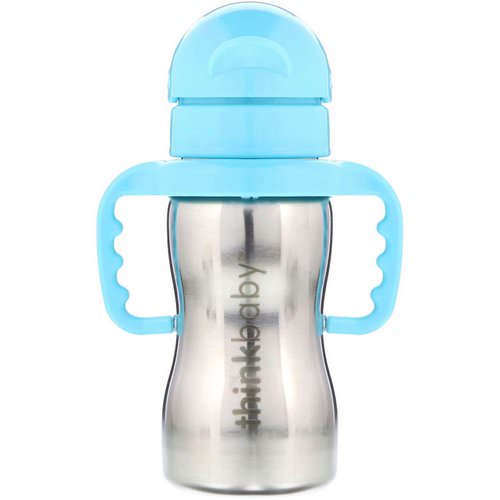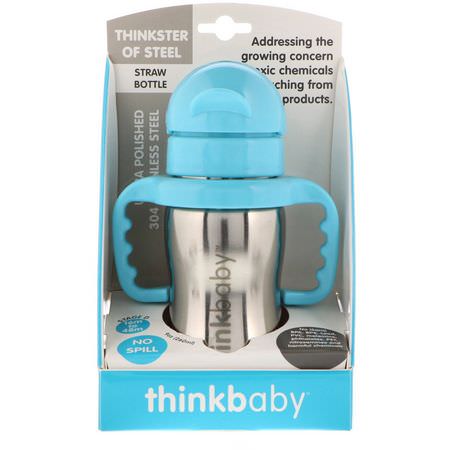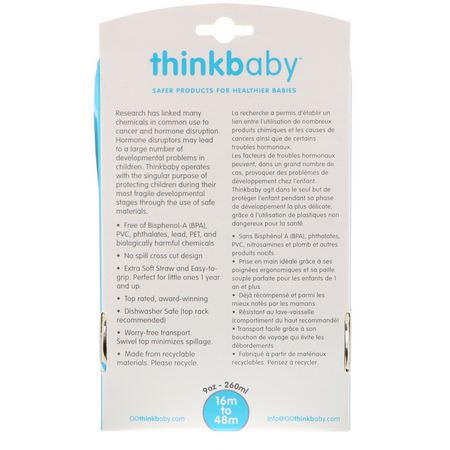Foodpharmacy Blog: Kids, Baby, Kids Feeding, Cups
Think, Thinkbaby, Thinkster of Steel Bottle, Blue, 1 Straw Bottle, 9 oz (260 ml)

$10.50
Product name: Think, Thinkbaby, Thinkster of Steel Bottle, Blue, 1 Straw Bottle, 9 oz (260 ml)
Quantity: 1 Count, 0.23 kg, 13 x 12.7 x 19.1 cm
Categories: Think, Baby, Kids, Kids Feeding, Cups, Bpa Free
Straw Bottle, Ultra Polished 304 Stainless Steel, Stage D – 16 m to 48 m, No Spill, No BPA, BPS, Lead, PVC, Melamine, Phthalates, PET, Nitrosamines and Harmful Chemicals, Addressing the growing concern of toxic chemicals leaching from baby products, Thinkbaby-Safer Products For Healthier Babies, Research has linked many chemicals in common use to cancer and hormone disruption. Hormone disruptors may lead to a large number of developmental problems in children. Thinkbaby operates with the singular purpose of protecting children during their most fragile developmental stages through the use of safe materials, Free of Bisphenol-A (BPA), PVC, phthalates, lead, PET, and biologically harmful chemicals, No spill cross cut design, Extra Soft Straw and Easy-to-grip. Perfect for little ones 1 year and up, Top rated, award-winning, Dishwasher safe (top rack recommended), Worry-free transport. Swivel top minimizes spillage, Made from recyclable materials.

In this way, the child can adjust to the new cup, while having the comfort of a familiar nipple before making the change to the new sippy cup spout. These sippy cups are cheap and i really wish we had started with these as an option! Designed for kids 12 months and older, the tommee tippee tumbler helps toddlers learn to drink out of grownup glasses. Unlike most sippy cups, the miracle 360 has no spout. You want the timing to be when baby is happy and willing to take the cup and hold it to drink. If you tighten this lid too much, your drinking child will leave a vacuum inside the bottle and the soft nipple will get sucked in. These sippy cups are amazing for getting your little one to move on from a bottle, while preventing huge spills. I had my baby yesterday, and i just wanted to give you a shout and say thanks so much for your awesome weekly emails. The sooner you start, the less attached your baby is to a bottle. Rating ease-of-use for straw cups is tricky, since kids will probably have no trouble at all with straws unless you switch back and forth between straws and spouts.
Think, Thinkbaby, Thinkster of Steel Bottle, Blue, 1 Straw Bottle, 9 oz (260 ml): Cups, Kids Feeding, Kids, Baby
Packed full of great kitchen essentials including bowls, plates, kitchen utensils, feeding sets, sippy cups, reusable snack bags, fruit bowls and training cups. In addition, children also do not grip their cups as tight as adults. The bite resistant spout keeps kids from ruining the cup, and the seal zone technology provides a 100 percent leak-proof, spill-proof, break-proof experience. While high quality plastics are common, there are still some cups made with glass for the best sterilization properties like the green sprouts glass sip and straw cup. 1 Week after switching to these, our toddler was able to take sips from regular open cups/glasses. Although some parents make a sippy cup available to their child all day long, the fact of the matter is that sippy cup use should be limited to only meal times. During the first year of life, a baby primarily uses an anterior-posterior tongue movement to propel soft solids and liquids to the back of the mouth for swallowing. These trainer cups hold up to 5 ounces of liquid. Hence, kids should not use them for too long. My goal with any dishes is to get them into glass as soon as possible, as i have an affinity for the montessori style of learning, which has kids using real things as much and as soon as possible. Once you start weaning and you get into a routine of feeding, you can introduce a drink of cooled boiled water at mealtimes. Which feature you choose is up to what works best for your child.

Each brand has a slightly varied spout, and your child may prefer a different brand over the one you originally chose. We rated the sippy cups from a score range of 1-5 (1 Being the leakiest) in the following tests: Inversion (Being held upside down), shaking while upside down and dropping on a hard floor from a height of about 22 inches. That being said, some of these sippy cups did way better in the dishwasher than others. If you want to go one step further, you can soak sippy cups in boiling water or use a bottle sterilizer to kill off any remaining bacteria. These sippy cups are intended for toddlers who have already made the transition from a bottle but still find it easier to drink from the spout. The sippy cups are 100% leak proof, spill proof, and break proof. These sippy cups are made from fda approved recycled milk jugs. Hard tops or straws are generally reserved for children over 1 and toddlers. First, it is important not to push your child too hard to transition. After my nephew cyrus expertly tested baby bibs, his mom/my sister happily obliged to take on a new task: Find the best sippy cup.
As you can see, it has nothing to do with sippy cups. There are many different sippy cups on the market that are widely praised by happy parents. However, if you still breastfeed the little one, you should reconsider, because breastfeeding and straw biting do not go well together, for obvious reasons. By nature, sippy cups are difficult to clean. Having a number of sippy cups allows you to exchange the sippy cup often for a fresh, clean cup. We had all love to think that the only thing that matters is whether or not the baby likes the cup, but honestly, if you hate using it, baby will never even see it. Since the cup may be too heavy for your baby to hold with just one hand, cups with handles for this stage are helpful. Sippy cups are suitable for babies older than six months. So as to manage and control the cups easy handles are provided on the either side of the cups.
If you find your child prefers using a product with a straw, the philips avent my bendy straw cup is the perfect product to pick up. The handle is open and flexible at the top, which enables your child to hold around the right sippy cup if preferred. There are sippy cups that have handles and sippy cups that have indents. Besides that, the handles are removable making it convenient for older kids to use. It’s also a good idea to run your child’s sippy cups through the dishwasher on occasion, as the high temperature helps to sanitize them and gets rid of any germs lurking in hard-to-reach nooks and crannies. They are slightly larger than the last cups, and they only feature one design: A penguin carrying three brightly-colored balloons. These cups usually come with spouts that can withstand intense chewing or any kind of abuse the user might put them through. When should a child stop using a sippy cup? It has handles on either side to make it easier for your child to hold the cup. First of all, the child learns how to handle the process of moving from sucking to one of placing the lips around the cup and allowing the beverage to pour into the mouth. Since these cups come in different variants and styles, it is vital to look for essential features in them so that the baby or toddler will properly benefit from them. Make sure to check the above information regarding materials for sippy cups as you can get a closer look to what you abot to buy.
Think Cups
Well, they are like regular cups that are usually made of plastics. But there are many types of infant cups. Katie kimball, csme is a trusted educator and author of 8 real food cookbooks. Let me preface this be saying i never write reviews, however when i saw how many people were saying mold was growing in their cups i was horrified so i made a video of me washing ours. This non-spill baby cup has a unique feature to help with the bottle-to-cup transition. It’s spoutless rim design is great for older toddlers who have graduated to open cups, but who still need spill protection on the go. And, more to the point, sippy cups promote immature sucking patterns that are appropriate for the bottle or breast, but not, as an increasing number of experts point out, for speech development. Hygiene is an important factor for a child at a very small age. Kids love bright colors and would easily reach out for these cups.
We’ve tried all these other cups, but they all leak, or grow mold where you cannot clean it, or both. There are a lot of cups sold today that tend to leak and spill, which could make a very big mess especially since the primary user of the cup is a baby or a toddler. Made from harmless plastic, the same material used in baby bottles, disposable diapers and food boxes. All good things rolled into one, with a design that would help your baby in slowly getting accustomed to drinking from a cup independently, because as your baby progresses, you could also remove the training handle and voila! Babies can be accustomed to the feel of breastfeeding and the closeness to their mom they enjoy during feeding. Remember, a sippy cup is meant to help your baby switch from a bottle or breastfeeding to a regular open cup. At the local mall, chances are you would be overwhelmed by the array of cute, sippy cups beckoning on you to buy. For a super affordable, on-the-go option, the first years take and toss sippy cups fit the bill. Created to grow with your child, one bottle can be used for years with a simple swap of silicone lids. Almost all of them do not have either of the handle and they have thin design and long body that provides good griping for child. It is a lot of work to help your child to grow and to become more independent. With this you can be sure that your child will no more spill the liquid on beds, cars etc. The philips website writes that dentists recommend the short straw for exercising mouth muscles, so it might be better for an older baby who has had more practice.
When your child is at very early age he needs something soft and easy to hold. It has easy-grip, anti-slip handles that are easy for babies to hold, which also could be taken off once your baby transitions to cup fully. We recommend going with the smallest for kids, as the larger sizes will probably be too heavy for them when filled with water. Explore a bit about the company and it’s history to determine if it is a legitimate manufacturer of baby products. Most babies are ready to start drinking from something other than a baby bottle around the age of 6-9 months, although some show no interest before 12 months of age.